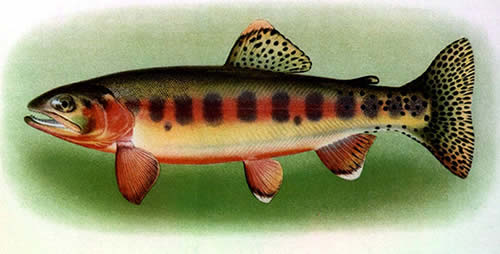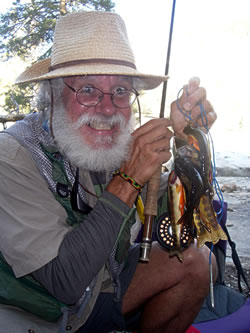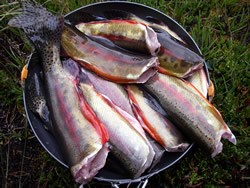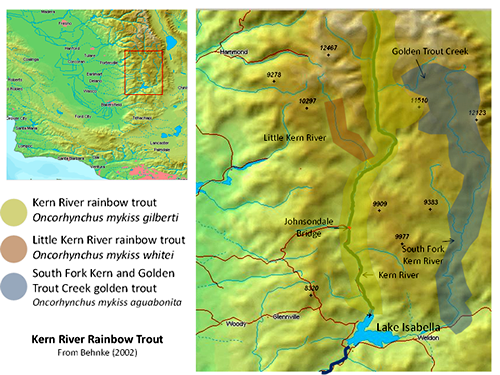Golden Trout
Joe Medeiros
Professor Emeritus, Botany, Sierra College
 Any High-Sierra angler will admit that this is the most beautiful trout in the world. In 1947, when the vote went out for a California state fish, there might have been some serious competition as there are more than 60 freshwater fishes in California. Much more recently (1995), a very showy orange/golden damselfish, the Garibaldi, was added to the list of California state symbols as our marine (saltwater) fish. But, back in 1947, the little freshwater trout known as the golden trout was selected as the state’s fish. (Assembly Concurrent Resolution No. 52—Chapter 90. Filed with Sec. State April 14, 1947)
Any High-Sierra angler will admit that this is the most beautiful trout in the world. In 1947, when the vote went out for a California state fish, there might have been some serious competition as there are more than 60 freshwater fishes in California. Much more recently (1995), a very showy orange/golden damselfish, the Garibaldi, was added to the list of California state symbols as our marine (saltwater) fish. But, back in 1947, the little freshwater trout known as the golden trout was selected as the state’s fish. (Assembly Concurrent Resolution No. 52—Chapter 90. Filed with Sec. State April 14, 1947)
In 1905, Barton Warren Evermann wrote of the fish in Golden Trout Creek:
This is the most beautiful of all the trouts; the brilliancy and
richness of its coloration is not equaled in any other known
species; the delicate golden olive of the head, back, and upper
part of the side, the clear golden yellow along and below the
lateral line, and the marvelously rich cadmium of the under
parts fully entitle this species to be known above all others as
the golden trout. In form, it is no less beautiful; its lines are
perfect, the fins large and well proportioned, and the caudal
peduncle strong; all fitting it admirably for life in the turbulent
waters in which it dwells.
No doubt, tens of thousands of freshwater fish were caught and consumed during the California Gold Rush, most of these being salmon and trout. But, the goldens were far from the reach of the Argonauts—these were fish of the high country, found only in the chilly waters of the high, southern Sierra—devoid of both gold veins and miners.
Trout are salmonids—members of a family of ray-finned fishes that stretch in size from the smaller trout, char, and graylings to the largest salmon (like the King or Chinook Salmon) that can weigh up to or more than 100 pounds. They are distant relatives of prehistoric Ice Age giants, like the sabertooth salmon which exceeded 9 feet in length! Many salmonid species (like salmon and steelhead trout) are anadromous—they hatch in freshwater and travel to the sea to live and grow before returning to their natal streams to spawn.
Our state fish is officially the California golden trout, Onchorhynchus mykiss aguabonita, considered by some to be a subspecies of the rainbow trout. Many others consider them to be a full (separate) species. The reasons for this tongue-twisting collection of foreign words used in its scientific name are thus:
- Onchorhynchus – Onkos is Greek for “hooked” and rynchos means “nose”. In many of the spawning adults, the jaws hook and overlap. Both Pacific salmon and true trout in the West share this genus.
- mykiss – mikizha is the Russian word for the Kamchatka rainbow trout – a very closely related Pacific species.
- aguabonita – named for Agua Bonita Falls where this unique fish subspecies was first found, where Volcano Creek enters Golden Trout Creek, just before it feeds into the main fork of the Kern River.
Salmonids have been around the west coast for more than 3 million years, a period which has seen the advancement and melting of continental glaciers, rise and fall (and rise again) of sea level, volcanic eruptions, the origins of mountain ranges, and many other major changes to the landscape. Salmon and trout thrived because they are superbly adapted to changing conditions, colonizing glacial rivers, following rivers inland to distant areas and using the ocean for dispersal. During these processes, many were stranded. Those that were landlocked couldn’t return to the sea, became isolated and evolved accordingly to their local conditions. Numerous variations on the trout theme flourished in cold streams all around the Pacific Ocean’s coastal margins. Some managed to move long distances inland and became the spectacular inland cutthroats of today. In California, only a few got past the waterfalls of the rising Sierra Nevada, also becoming genetically isolated: the redband trouts, Eagle Lake rainbow, and three varieties of golden trout.
Our California golden trout was first formally described by the “father of ichthyology”, David Starr Jordan, in 1892. He had just become the first president of new Stanford University when he gave the fish its scientific name of Salmo aguabonita. Without the sophisticated technologies and equipment available to biologists today, it was impossible to ascertain if the golden trout had become isolated from its rainbow trout ancestry. In his report to the National Museum (Volume 15 1:92, pp. 481-483) he considers that it might have been derived from a cutthroat trout from the Great Basin. The specimens he was working with were collected in 1875, perhaps the first record of this trout in written history.
No Trout in the Sierra High Country?
It turns out that there were probably very few places in the western Sierra with fish above 6000 feet before we (Euro-Americans) got here. The waterfalls were simply too tall for the small trout to get any farther upstream. The exception was in the southwestern Sierra—in the Kern River watershed. There, where ancient faults had created north-south trending gorges that would later be deepened by rivers, a group of rainbow ancestors pressed farther into the heart of the southern mountains and higher than any others. Here they colonized many headwater streams above eight thousand feet in elevation—a region largely unglaciated during the last 10,000 years or so.
Today we recognize three subspecies of rainbow trout in the Kern River that many would consider “goldens”—the Little Kern golden trout (Onchorhynchos mykiss whitei), the California golden trout (Onchorhynchos mykiss aguabonita) and the Kern River rainbow trout (Onchorhynchos mykiss gilberti). It takes a sharp-eyed and experienced angler to separate them from each other (unless you know exactly where you’re fishing). The Little Kern are found, of course, in their native habitat, the little Kern River. The Kern River rainbows are heavily spotted trout found in the main Kern River above Durrwood Creek and all the way into Sequoia National Park and currently to Junction Meadow. Our official state fish, the California golden trout (sometimes known as the Volcano Creek golden trout) are found in the cold and clear streams of Golden Trout Creek and the uppermost reaches South Fork of the Kern River. Confused? Just go fishing! But don’t forget to release the little golden beauties after you’ve had a quick look and taken a picture. Why? Because our beautiful state fish is in danger of going extinct! Here’s why.
Close to Extinction
Intentionally or inadvertently we humans, especially when we show up in large numbers with technologies that mother nature hadn’t planned on, we upset the biological and ecological apple cart. The California golden trout is only one of myriad California species that is endangered because of our activities. For our state fish, such activities include transplanting them to other locations, mingling them with other closely-related native fish species, introducing non-native species into their habitats and disturbing their aquatic (and nearby upland) habitats.
Recall, the golden trout became isolated (geographically as well as genetically) in the high country (7,000 to 10,000 feet) of the southern Sierra Nevada. There they enjoyed only natural (including the occasional Native American human) predation for thousands of years. Eventually, along came the cattlemen and the cowboys who, no doubt, enjoyed this delicious subspecies of the rainbow. But, humans are never satisfied with the way things are (the way Mother Nature set our table). There were thousands of fishless lakes and hundreds of miles of fish-free streams in the High Sierra. Fishless, yes—but devoid of life, no. Humans must have been too hungry to notice that there were many other species that evolved in these crystal-clear waters (the devastating effects of introduced hungry fish in frog-dominated high-country watercourses is another story all together).
By the turn of the century, there were concerns that golden trout were being over-fished. Stewart Edward White, the famous western novelist wrote about the threat in 1904 in his novel The Mountains. He shared this with his friend President Teddy Roosevelt who dispatched biologist Barton Warren Evermann out west to study the situation in 1906. The result led to many a rescue proposal, including translocations of the fish to other suitable waters.
Messing With Mother Nature
Probably the first step of our meddling in this fish’s evolution began in 1876. Hearing there were trout on the west side of the Sierra’s crest, Colonel Sherman Stevens journeyed into Mulkey Creek (a tributary of the South Fork Kings) and brought 13 golden trout four miles over the Hockett Trail in a coffeepot because he wanted fish in Cottonwood Creek. Just as the Mulkey Creek goldens had been transplanted earlier, he hoped to establish a population at his sawmill on the eastern slope of the Sierra. The fish took readily to the fishless Cottonwood Creek waters and flourished there.
In 1891 about 100 golden trout were transported upstream to the Cottonwood Lakes, beyond numerous impassable barriers. Fingerlings from these lakes were then transplanted elsewhere in the Sierra and later (after 1917) these lakes, high at the head of Cottonwood Creek would be used by California’s Fish and Game Department as a source of eggs to take to the Mount Whitney Fish Hatchery. The hatchery was on Oak Creek, more than 20 miles northward, near the little town of Independence. From there, fingerlings were transplanted into hundreds of western mountain locations. Shipments were even sent as far away as the UK and Brazil. Our little goldens eventually became dispersed in the cold, clear waters throughout the Sierra (in more than 300 lakes and 700 miles of streams), as well as in Arizona, Colorado, Idaho, Montana, New Mexico, Nevada, Oregon, Utah, Washington, and Wyoming. Most of these fish today, unfortunately, are probably hybrids with rainbow.

The Mount Whitney Fish Hatchery is still open for occasional tours. Its beautiful main building and serene grounds remain, but only after it was severely damaged. In 2008 heavy rains overloaded the Oak Creek watershed above. Previous fires had burned the watershed’s forests and the floods triggered a huge debris flow that overwhelmed the hatchery’s rearing ponds (then filled with only rainbow trout). Before this, however, the goldens that were being raised there became suspect. Somehow, (some think in the 1930s) they had been mixed with rainbow trout and introgression (hybrids mate with parent types) had occurred—they were no longer pure golden trout. Tens of thousands golden x rainbow hybrids were now loose in the west.
Competition and Hybridization
In Sam McGinnis’ book, Freshwater Fishes of California, he describes a “golden conundrum.” He named it “The Golden Spike, the Golden Trout and the Golden State.” He states,
“An event in Utah in 1869 marked the beginning of the end for the pristine California fish fauna. This was the completion of the first transcontinental railroad. Prior to that time, it was extremely difficult to bring eastern species of fish to the far West……
And he continues:
But the blossoming of the railroads in the West in the 1870s made possible the fulfillment of the western fish importer’s dreams, and soon many ecologically unsound whims and schemes became reality as eastern species were poured into California waterways.”
 While golden trout and their hybrids were being shipped around the west, numerous non-native fishes were also being introduced into Sierran waters. Besides the native rainbow trout (ancestors of the golden) being ushered up the waterways and into golden trout territory, two additional newcomers were brought west—the brown trout from northwestern Europe and the brook trout (a char) from America’s east coast. Once introduced into Sierran waters, both species competed aggressively for food and habitat. The prolific brookies could functionally out-reproduce the goldens and the browns aggressively outcompeted them for food (they included the fingerlings of goldens in their menu).
While golden trout and their hybrids were being shipped around the west, numerous non-native fishes were also being introduced into Sierran waters. Besides the native rainbow trout (ancestors of the golden) being ushered up the waterways and into golden trout territory, two additional newcomers were brought west—the brown trout from northwestern Europe and the brook trout (a char) from America’s east coast. Once introduced into Sierran waters, both species competed aggressively for food and habitat. The prolific brookies could functionally out-reproduce the goldens and the browns aggressively outcompeted them for food (they included the fingerlings of goldens in their menu).
Threats From All Sides
Cumulative threats by humans to the golden trout began with overfishing—beyond the ability for the species to reproduce. Later, between hybridization (with rainbows), competition (brook trout) and predation (brown trout), what else could possibly go wrong? Well, what about habitat degradation?
The Sierra Nevada high country has long been known for its summer pastures for cattle grazing. Long after the lower elevation grasslands were parched and dry, anywhere a cow could be driven to green forage was fair game. For more than 150 years, the high pastures have been summer home to cattle and sheep—no friends to the mountain meadows through which most golden trout streams flow. Meadows and upland habitats were overgrazed, leading to soil erosion. Nutrient loads (manure as fertilizer) were added to the watercourses as well as fine sediments that decrease spawning success.
While this sounds overwhelming, and even futile for our little state fish, all is not lost (thanks to fish biologists and geneticists, the Endangered Species Act, the US Forest Service, California’s Department of Fish and Wildlife, hundreds of dedicated fish fanatics and trout-centered organizations).
Still On the Edge of Extinction
Today, the status of the California golden trout subspecies is precarious and much has been done to avert their extinction. In 1978, the U.S. Fish and Wildlife Service (USFWS) listed the Little Kern golden trout as “threatened.” Recovery efforts have taken place since 1975, removing rainbows and hybrids from the Little Kern River. Restocking with pure Little Kern golden trout has been tentatively successful. The California (Volcano Creek) golden trout is a California State Species of Special Concern (1995) and is classified by the US Forest Service as a Sensitive Species. While numerous worrisome hybrids were previously found, fish biologists are now working with pure California golden trout in the Golden Trout Creek and upper South Fork Kern drainages.
Threats to golden trout populations came from potential rainbow trout hybridization, competition by brook trout and predation by brown trout. Since 1966 an enormous effort has been undertaken along the upper South Fork Kern watershed to rid of introduced rainbows and browns, and to prevent them from moving northward into golden trout territory upstream. Three man-made barriers were constructed—gabions (wire-caged, boulder-filled cubes) and concrete dams. These were designed to create waterfalls too tall for either rainbows or brown trout to pass. Since they were installed, they have had to be rebuilt and reconstructed as they deteriorate in time. They are currently very (but not perfectly) successful.
Wilderness Refuge
In 1978, the 304,000-acre Golden Trout Wilderness was established within the Sequoia and Inyo National Forests—on the Kern Plateau—all within the much-drier and unglaciated southern Sierra Nevada. The South Fork Kern and numerous creeks run through higher (7000-9000-foot altitudes) dry meadows. Lower elevations support open pinion pine forests but the wilderness area includes upper elevations with Jeffrey, lodgepole and foxtail pines. Nearby peaks often exceed 10,000 feet and the southernmost 12,000-foot peak (Olancha Peak) is visible at a distance. Access to this large montane grassland and meadow area has always been relatively easy—first by cattle and their cowboys, later by fishermen and today by hikers along the Pacific Crest Trail.
After decades of efforts in this region to safeguard the purity of the California golden trout, legendary fish biologist E. P. (Phil) Pister included a poem in a publication about the golden trout projects along the South Kern. His publication begins with a fish-loving angler and conservationist from Kernville, waxing eloquently about his relationship to our little goldens:
From primal shores down ages dimly past
You fled your salt tide for our rendezvous.
What geologic eons nurtured you
In utter isolation where, at last,
You shed the steelhead, then the rainbow cast
To match the sunset, don its aureate hue?
Across your parr-mark shines the yellow spew
Of clouds embroiled on mountains dim and vast.
An errant soul, enamored of your spell,
Beholds the ancient miracles in store
Where meadowlands bear sun-reflecting dreams.
By devious ways, in ages none can tell,
I, too, migrated from a primal shore
To win perfection in your golden streams.
— Ardis M. Walker
The story of protecting the California golden trout and the Little Kern golden trout is far from over. This story, and many others like it exemplify the struggle to preserve pure species around the world. But why? Aldo Leopold (A Sand County Almanac) once wrote:
A thing is right when it tends to preserve the integrity, stability and beauty of the biotic community. It is wrong when it tends otherwise.
Stanford University population biologist Paul Ehrlich wrote:
The first rule of intelligent tinkering is to save all the parts.
Phil Pister and other conservationists often liked to quote Stephen Jay Gould:
We are trapped in the ignorance of our own generation.
Resources
- https://watershed.ucdavis.edu/news/2017/05/16/state-salmonids-ii-fish-hot-water
- California Department of Fish and Wildlife (DFG)
California Golden Trout
https://www.dfg.ca.gov/fish/Resources/WildTrout/WT_CaGoldenDesc.asp
California Golden Trout, Oncorhynchus mykiss aguabonita ...
- https://nrm.dfg.ca.gov/FileHandler.ashx?DocumentID=104274
- Kern River Rainbow Trout
https://www.dfg.ca.gov/fish/Resources/WildTrout/WT_KernRivRbwDesc.asp
Kern River Rainbow Trout, Oncorhynchus mykiss gilberti ...
- https://nrm.dfg.ca.gov/FileHandler.ashx?DocumentID=104325
- Little Kern Golden Trout
http://www.dfg.ca.gov/fish/resources/WildTrout/WT_LKernGldDesc.asp - From California Fish Website (UCDavis)
http://calfish.ucdavis.edu/species/?uid=117&ds=241
Other Resources
Images
- Fish painting by Charles Hudson
- Trout planting packtrain from Phil Pister collections
- Hybrid extraction photos by the author
- Golden Trout of the High Sierra. Leonard Fisk. State of California. The Resources Agency. Department of Fish and Game. Pamphlet. 16pp. 77072-800 3-83 10M CS OSP
- David Starr Jordan (1892-07-24). "A description of the golden trout of Kern River, California, Salmo mykiss agua-bonita.". Proceedings United States National Museum xv: 481–483.
- Molly R. Stephens (2007). Systematics, genetics and conservation of golden trout. Ph.D. dissertation. (PDF). University of California Davis.
- Moyle, P.B. 2002. Inland Fishes of California. Revised and Expanded. Berkeley: University of California Press. 502pp.
- Moyle, P., R. Lusardi, P. Samuel, and J. Katz. 2017. State of the Salmonids: Status of California’s Emblematic Fishes 2017. Center for Watershed Sciences, University of California, Davis and California Trout, San Francisco, CA 579 pp.
https://watershed.ucdavis.edu/files/content/news/SOS%20II_Final.pdf
